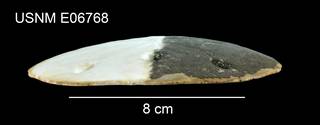
| Introduction | | Search taxa | | Taxon tree | | Specimens | | Attributes | | Literature | | Photo gallery | | Stats | | Log in |
Echinoidea name detailsEncope wetmorei A.H. Clark, 1946
513260 (urn:lsid:marinespecies.org:taxname:513260)
unaccepted (subjective junior synonym)
Species
Encope (Echinadesma) wetmorei A.H. Clark, 1946 · alternative representation
marine,
recent only
Clark, A. H. (1947). Echinoderms from the Pearl Islands, Bay of Panama, with a revision of the Pacific Species of the Genus <i>Encope</i>. <em>Smithsonian Miscellaneous Collections.</em> 106: 1-11., available online at http://www.biodiversitylibrary.org/page/27394366#page/133/mode/1up
page(s): 2-5; pl. 1: fig. 1, pl. 2: fig. 1 [details]
Distribution Pacific Ocean
Distribution Pacific Ocean [details] Status While Coppard & Lessios (2017) did not formally synonymize E. wetmorei with E. micropora, it is clear from their paper that...
Status While Coppard & Lessios (2017) did not formally synonymize E. wetmorei with E. micropora, it is clear from their paper that they consider them to be synonyms. They wrote: "However, with the exception of specimens of E. micropora insularis from Isla Socorro, there was no structure to support these variants [of E. micropora] either in morphology (as indicated by the specific and subspecific names) or in geographical location. Subclades did not include all members of a morphospecies; the same subclade included morphologically divergent specimens, such as those of E. micropora micropora, mixed with E. wetmorei and E. laevis. [details]
Kroh, A.; Mooi, R. (2021). World Echinoidea Database. Encope wetmorei A.H. Clark, 1946. Accessed at: http://www.marinespecies.org/echinoidea./aphia.php?p=taxdetails&id=513260 on 2024-04-18
Date action by
original description
Clark, A. H. (1947). Echinoderms from the Pearl Islands, Bay of Panama, with a revision of the Pacific Species of the Genus <i>Encope</i>. <em>Smithsonian Miscellaneous Collections.</em> 106: 1-11., available online at http://www.biodiversitylibrary.org/page/27394366#page/133/mode/1up
page(s): 2-5; pl. 1: fig. 1, pl. 2: fig. 1 [details] basis of record Mortensen, T. (1948). A Monograph of the Echinoidea. IV, 2. Clypeasteroida. Clypeasteridæ, Arachnoidæ, Fibulariidæ, Laganidæ and Scutellidæ. 471 pp., C. A. Reitzel, Copenhagen. page(s): 443 [details] basis of record Kier, P. M. & Lawson, M. H. 1978. Index of living and fossil echinoids 1924-1970. Smithsonian Contributions to Paleobiology 34, 1-182., available online at https://doi.org/10.5479/si.00810266.34.1 page(s): 72 [details] Available for editors status source Coppard, S.E. & Lessios, H.A. (2017). Phylogeography of the sand dollar genus Encope: implications regarding the Central American Isthmus and rates of molecular evolution. <em>Scientific Reports.</em> 7(1): 11520., available online at https://doi.org/10.1038/s41598-017-11875-w [details]  Present Present  Inaccurate Inaccurate  Introduced: alien Introduced: alien  Containing type locality Containing type locality
Paratype (of Encope (Echinadesma) wetmorei A.H. Clark, 1946) USNM 10017, geounit Mexican Exclusive Economic Zone [details]
Paratype (of Encope (Echinadesma) wetmorei A.H. Clark, 1946) USNM 3081, geounit Mexican Exclusive Economic Zone [details]
From editor or global species database
Distribution Pacific Ocean [details]Status While Coppard & Lessios (2017) did not formally synonymize E. wetmorei with E. micropora, it is clear from their paper that they consider them to be synonyms. They wrote: "However, with the exception of specimens of E. micropora insularis from Isla Socorro, there was no structure to support these variants [of E. micropora] either in morphology (as indicated by the specific and subspecific names) or in geographical location. Subclades did not include all members of a morphospecies; the same subclade included morphologically divergent specimens, such as those of E. micropora micropora, mixed with E. wetmorei and E. laevis. [details]
To Barcode of Life (22 barcodes)
To Biodiversity Heritage Library (5 publications) To European Nucleotide Archive (ENA) To GenBank (110 nucleotides; 66 proteins) To NMNH Extant Collection (Encope wetmorei USNM E06768 - dorsall) To USNM Invertebrate Zoology Echinodermata Collection (3 records) To USNM Invertebrate Zoology Echinodermata Collection (Holotype USNM 6768) |


